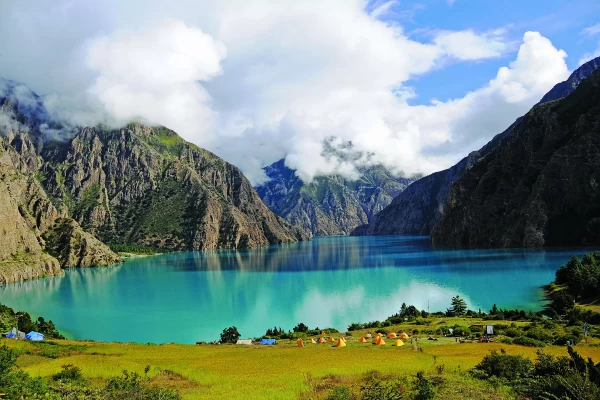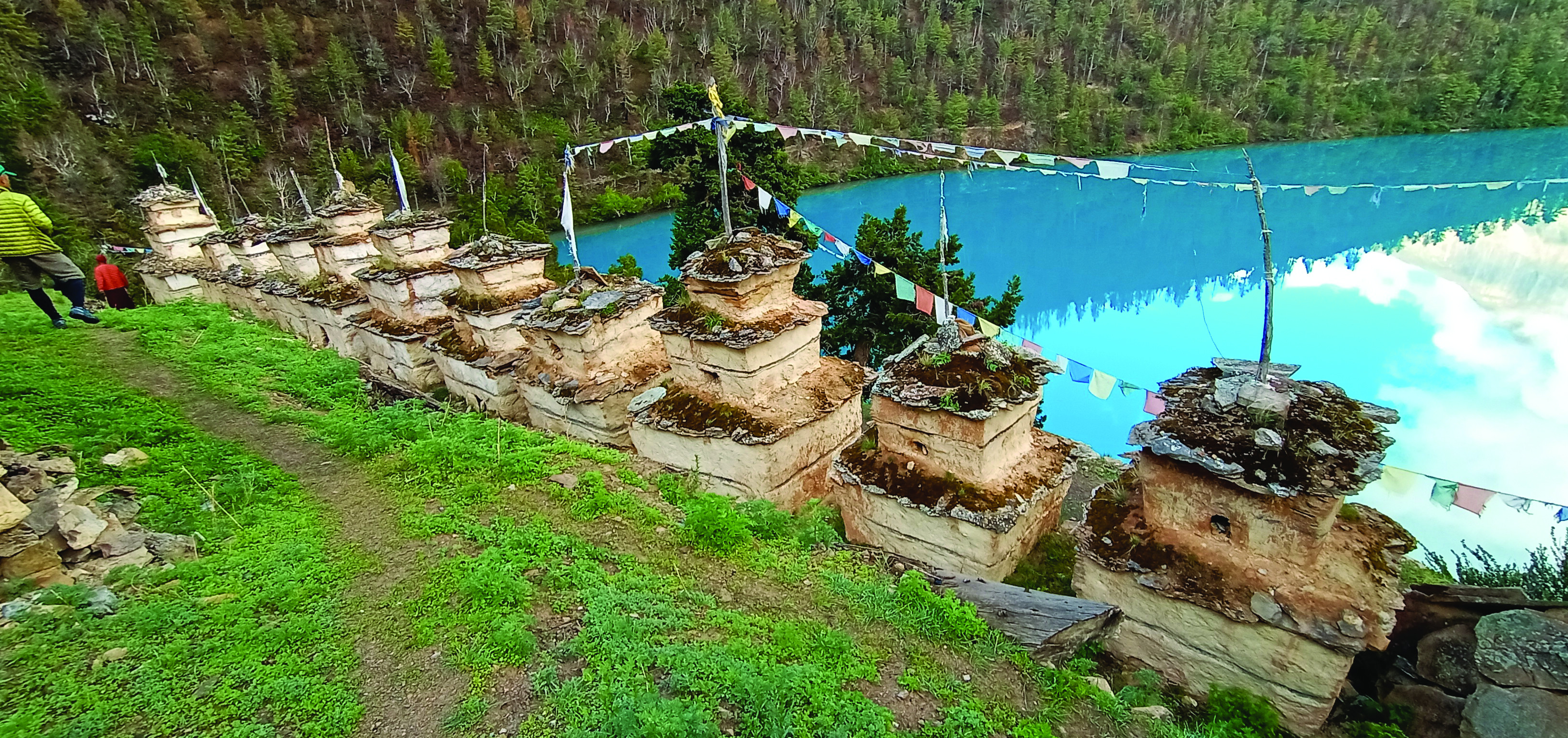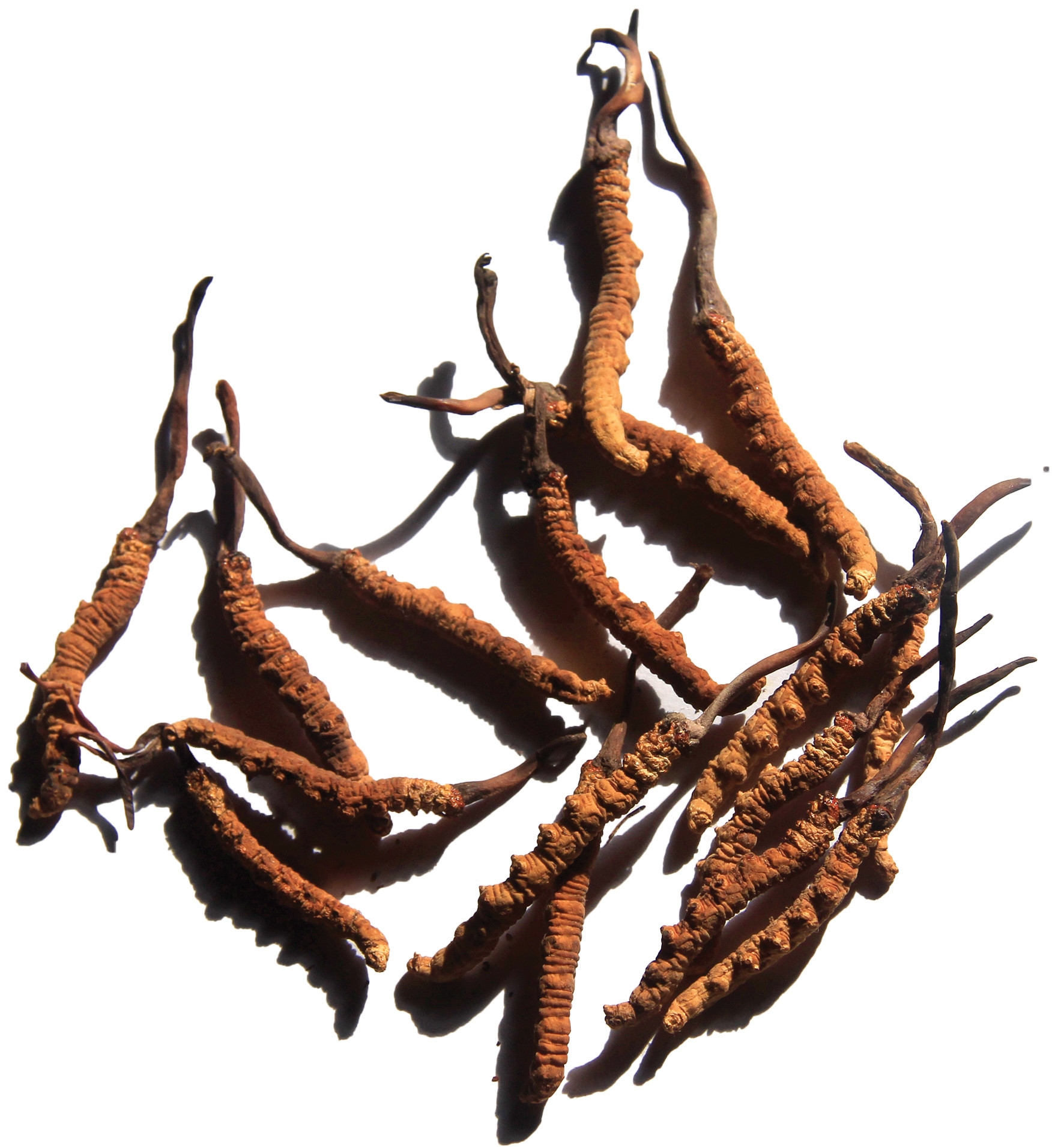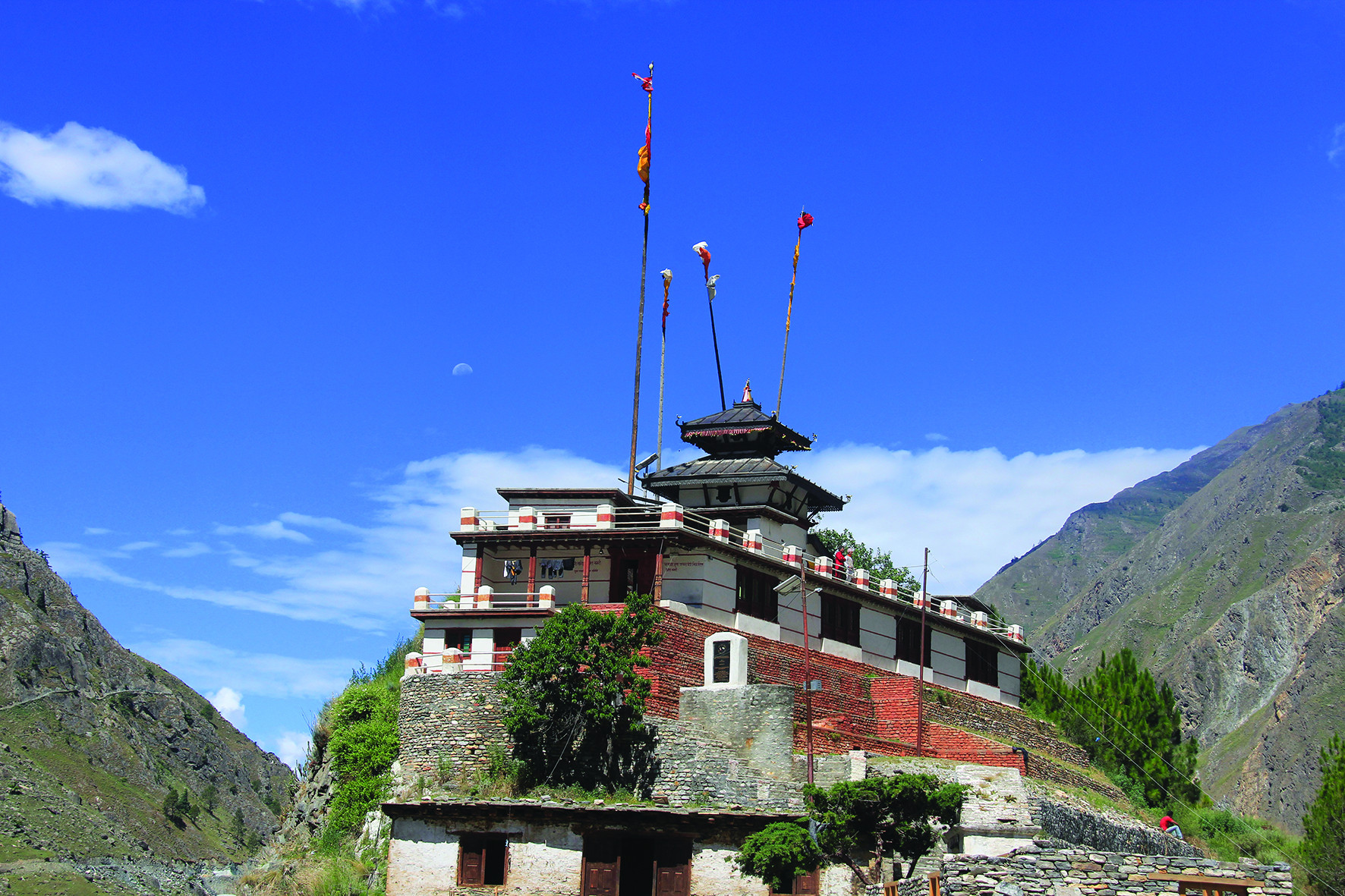Phoksundo Trek

Dolpa (locally pronounced as Dolpo) besides being the largest district in Nepal, covering an area of 5.36% of the country’s total land is renowned for its amazing natural beauty, unique religion and warm-hearted people. Bordered towards the north and northeast with the Tibet Autonomous Region, China, Mustang towards the east, Myagdi, Jajarkot and Rukum in the south and Jumla and Mugu towards the west, Dolpa still has its own unique culture.

For centuries, the local people cultivated and grew their own food which consisted of buckwheat, barley, maize, potatoes, etc. The only means of transportation was a yak caravan that carried salt from Tibet to the southern plain in exchange for food grains and commodities. The region was only accessible by foot and the trail meandered through the high passes of Mustang, Dhorpatan region, Rukum and Jajarkot until the operation of an airport.
The airport, located at Juphal, has irregular flights from Nepalgunj. Recently, Nepal Army completed a rural track that connects Dolpa with Dunai (the headquarters of the district from the south). The land was restricted to foreign trekkers until 1989.
The Phoksundo trek gives you a glimpse into the lives of the local people and their Himalayan lifestyle, against the backdrop of amazing landscapes and crystal clear lake. The blue lake is situated at an altitude of 3,611 meters. The trek passes through the lush green forest, waterfalls, pristine springs and rivers. Wildflowers bloom during the monsoon and you will get snow clad views of Mt. Kanjirowa and Kang Tai Tonh Himal. You will even encounter centuries-old chortens and Bon monasteries at different villages.
Phoksundo Trek Diary
I set off for the trek with a team of writers and journalists during the last week of June. I had reached Radi two days earlier from Khalanga in the Rukum district while my other team members took a flight from Nepalgunj to Juphal. My journey began after I crossed the suspension bridge at Thuli Bheri River in Radi and passing Tallu Bazar which was a 4.5 hours jeep ride along the Bheri River, Khadang, Kanchhi Bazar in Tipurakot; a small town in lower Dolpa.
While waiting for my team to arrive, this was the perfect chance to explore Tipurakot. I spent two days visiting Tripura Sundari Temple and walking around the small town. On the third day, I headed towards Dunai by crossing Suligad which is the main gateway to Phoksundo and Upper Dolpa.
I followed the trail beside the army barrack, leaving behind the Bheri River and I finally reached the checkpoint of the Shey Phoksundo National Park. I continued my trek along Phoksundo Lake and reached Kageni. It was a gentle and steady trail with a few ascents and descents. The blue waters of Phoksundo Lake never left me throughout my trek. As I climbed up higher and deeper into the woods, the traill had gentle climbs with the lush green forest through Rhyachi.
The next day of the journey continued till Chunubar passing through Samduwa.
The final day was an exciting morning as we only had a few hours left to reach Phoksundo. The trail was a gentle path for half and hour but then became a steep climb - which was tiring! The day started with an exciting morning as it left a few hours to reach the destination. The path followed the gentle trail for half an hour, then ascended steep climb. It was tiring and sweating hike. We saw beautiful Phoksundo waterfall enroute.
Finally, it was there, beautiful Phoksundo lake. The blue Phoksundo lake across beautiful Rigma village at a nearby distance. Yes, it’s now closer, mesmerizing scenes was around us. Shortly, we reached most-awaited Lake.
The lake is 27 kilometers from Suligad. Trekking from Suligad takes two and a half days. It is a comfortable trek. The first day takes around 7 hours and you can overnight at either Sangta or Chhepka. The second day is a 7 hour trek to Chunubar and it takes 4 hours to reach Phoksundo on the third day.
Side Trek to Pugmo: A Hidden Village
At an hour’s distance from the main trail at Phoksundo is Pugmo Village (3,200 meters). It is at a distance of 4.3 kilometers, left from Samduwa. The village has 35 houses built with stone , wood and mud. Bhote communities live in these humble homes. Agriculture and livestock are their major occupations. There is a Bon monastery built during the 15th century known as Namgyal Lakhang.
Fee & Permit: Lower Dolpa trekking permit - US$20 for a week, Shey-Phoksundo National Park - NRs. 3000
Tripura Sundari Temple
Tripura Sundari is the resident goddess deity of the temple. The temple is situated in a hilltop at an elevation of 2,101 meters near Tipurakot town. The temple is seated on the lap of Mukuteswor Himal, Tamrvani River in the west,Kagmara Himal in the north and Bahiravi Ganga in the south. At close proximity is a mix settlement of Kathayat, Brahman, Bista and Dalit communities.
It is believed that devotee’s wishes are fulfilled when worshipping the goddess. A per legend, there were nine goddess sisters, three of which live here and the rest migrated to Kalikot, Bajura, Salyan, Banke and Baitadi.
A large number of devotees from Nepal and India visit the temple every year.
Phoksundo lake - Jewels of Dolpo
In Caravan ( Himalaya), a famous 1999 Oscar-nominated film directed by French filmmaker Eric valley has skillfully captured the beauty of turquoise blue colored Phoksundo lake and Dolpo region. The film has portrayed tough lifestyles Dolpo people as salt traders.
The total area of the lake is 4.95 sq. km. Its length is 5.93 km, breadth is 1.80 km and depth of 145 m. The lake is enlisted as a Ramsar site on 23 Sept 2007.
The color of water changes as per the sky color. On the bank of the lake lies centuries-old Bon monastery, Rigma Village, and stupas. A 2.5-hour uphill walk to the viewpoint is worth rewarding to have an entire view of the mesmerizing lake.
Phoksundo lake is a 27 km distance from Suligad. It is reachable in two and a half days on the comfortable trek. On the first day, it takes 6-7 hours and overnight stays at Sangta or Chhepka. The second day, 7-hour trek to Chunubar and third day, 4 hours to reach Phoksundo. However at a faster pace, you could make it in two days.
Yarshagumba
 Dolpo is the center of the highly-priced Yarsagumbu (scientific name cordyceps sinensis) a half-plant and insect. In Bhote language, Yarsha meaning monsoon mushroom and gumbu as winter insects. Yarshagumbu is a medicinal herb grown in the highlands above 3500 m to 5200 m. The herbs are believed to help strengthen the immune system and even has aphrodisiacs purposes. Its regular uses help in reducing aging, prevent cancer and improve kidney functions. Thousands of local people including from the neighbouring districts of Rukum and Jajarkot flocks into the highland and passes to harvest these expensive medicinal herbs every year.
Dolpo is the center of the highly-priced Yarsagumbu (scientific name cordyceps sinensis) a half-plant and insect. In Bhote language, Yarsha meaning monsoon mushroom and gumbu as winter insects. Yarshagumbu is a medicinal herb grown in the highlands above 3500 m to 5200 m. The herbs are believed to help strengthen the immune system and even has aphrodisiacs purposes. Its regular uses help in reducing aging, prevent cancer and improve kidney functions. Thousands of local people including from the neighbouring districts of Rukum and Jajarkot flocks into the highland and passes to harvest these expensive medicinal herbs every year.
Trekking Itineraries
Day 1: Kathmandu to Nepalgunj (By bus or air)
Day 2: Nepalgunj to Juphal , 2475m (By air)
Juphal to Suligad,2075m (30 minutes jeep ride) and trek to Chhepka 2670m
Day 3: Chhepka to Saaijal,3130m (trek for 6 to 7 hours)
Day 4: Saaijal to Phoksundo 3611m (trek for 3 to 4 hours)
Day 5: Phoksundo - Chhepka or Kageni (trek 7 to 8 hours)
Day 6: Kageni - Suligad - Juphal (trek for 5 to 6 hours)
Day 7: Juphal to Nepalgunj (35 minutes by air)
Accessibility
35 minutes flight from Nepalgunj to Juphal and you can either trek or take a ride to Suligad. You can take an 18 hour bus ride from Kathmandu to Radi and then an 8 hours jeep ride.
Travel Advice
● Altitude sickness might occur above 3,000 meters - so take medicine
● Drink plenty of water and walk slowly in constant pace.
● Respect the local culture and religion.
● Do not spoilt the pristine and natural environment.
● If possible, donations to gompas and temples are acceptable.

